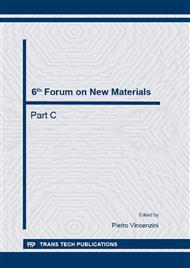p.1
p.11
p.17
p.23
p.27
p.32
p.38
p.44
p.50
The Possibilities of Graphenes Application in Textronic Devices
Abstract:
Graphene, because of its exceptional properties such as very good electrical conductance, flexibility and high optical transparency in visible light spectrum, has proved to be an excellent nanomaterial for modern electronic applications. The natural point of view is to use this new nanomaterial for the development of unique textronic devices such as sensory systems for monitoring human body’s vital functions and atmospheric composition. The present review shows the state of art of materials science and possibilities of the smart textiles design with graphene. The most promising applications of graphene for the design of textronic devices are the development of conductive polymer composites (CPC) and the development of inks and pastes for printing conductive tracks on textile materials. The preliminary results of implementation of 2D carbon structure into textronic devices are presented.
Info:
Periodical:
Pages:
27-31
Citation:
Online since:
October 2014
Authors:
Keywords:
Price:
Сopyright:
© 2014 Trans Tech Publications Ltd. All Rights Reserved
Share:
Citation:



